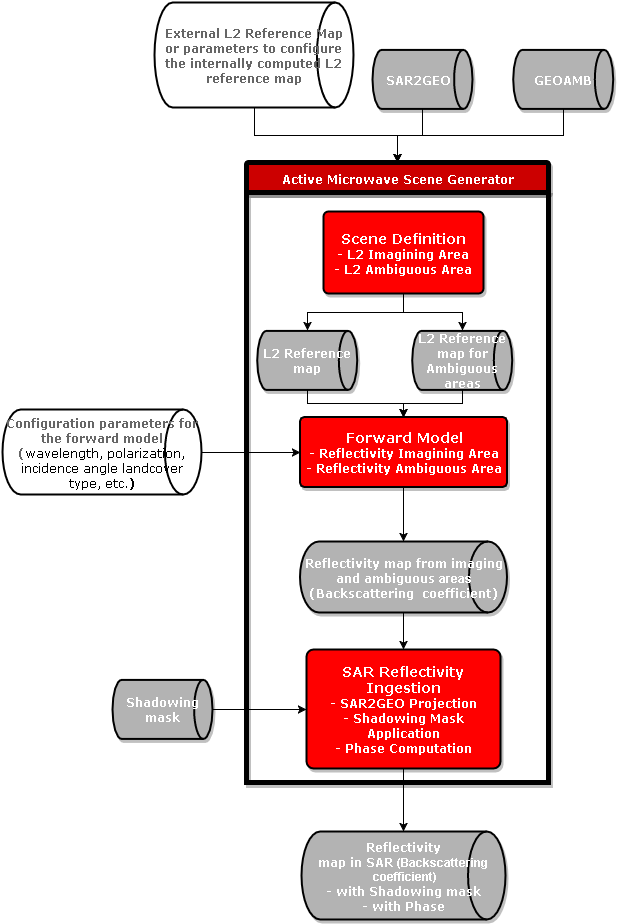Instruments
Active Microwave
Scene Generator
The Scene Generator Module is in charge of simulating the scene to be observed, and all environmental effects to be considered for the correct generation of the stimuli to be entered to the instrument model. In particular, for Active Microwave systems, the Scene Generation Module is in charge of providing the Reflectivity map of the area observed by the instrument on ground depending on the frequency of the signals transmitted by the instrument and on the geo/bio-physical characterization of the scene.
The computation of the Reflectivity map from the biophysical parameters is decomposed in several steps
The following Blocks have been identified:
- Scene Definition – geo/bio-physical parameters
- L2 Imaging area
- L2 Ambiguous area
- Forward Model – calculation of the reflectivity map (backscattering coefficient)
- Reflectivity Imaging area
- Reflectivity Ambiguous area
- SAR Reflectivity Ingestion – translation of the reflectivity map to SAR coordinates, calculation of the shadowing mask and addition of the phase.
- SAR2GEO Projection
- Shadowing Mask Application
- Phase Computation
Biblos.COTS This is Biblos COTS package with installation script. Script installs libraries:- kissFFT- boost- netcdf- zlib- hdf5- eigen
Biblos.Resampling The Resampling Block interpolates the input external image to the Scene Generator Module to the observation are as calculated by the Geometry Module. The external input image to this Block is either an image in Top-of-Canopy (TOC) reflectances or an image in the biophysical parameter. The output of the Block is the same (TOC or bio/geophysical parameter), resampled to the lat/lon grid defined in the geometry AOCS/Instrument coupling Block matrix. Input image should have a finer resolution than the observation area grid with already applied sampling factor. For each detector element, the Instrument Projection algorithm projects the pixel array onto the imaging area. The energy received depends on the Instantaneous Field Of View (IFOV) and pixel dimensions. In BIBLOS a constant nominal pixel size is considered. There is no attenuation considered due to pixel size. In the following equation, size_pixel is considered equal to size_ref.
Biblos.Commons This is a package common for all the Blocks and Modules. Commons contain helper functions e.g. for reading NetCDF or parsing XML files as well as Blocks and Modules interfaces.
Tool: Tiff to NetCDF converter BIBLOS works with NetCDF format for the images. This is a tool to convert Tiff to NetCDF. It is external to BIBLOS, the user shall convert the image offline. THe package includes an executable, a README file (with instructions) and an example auxiliary file.

